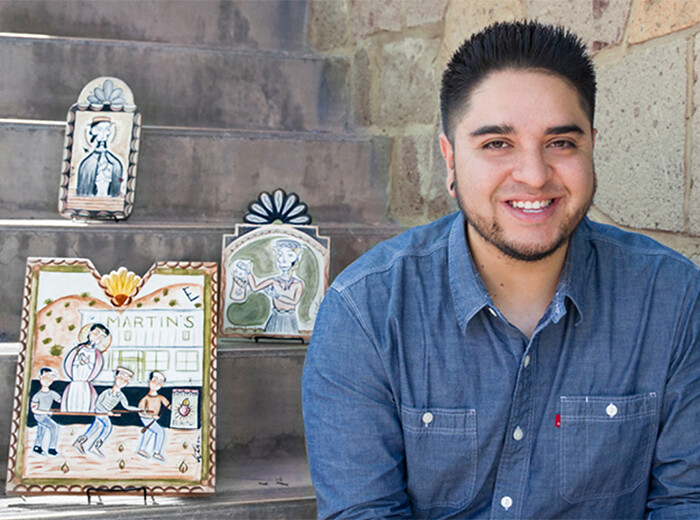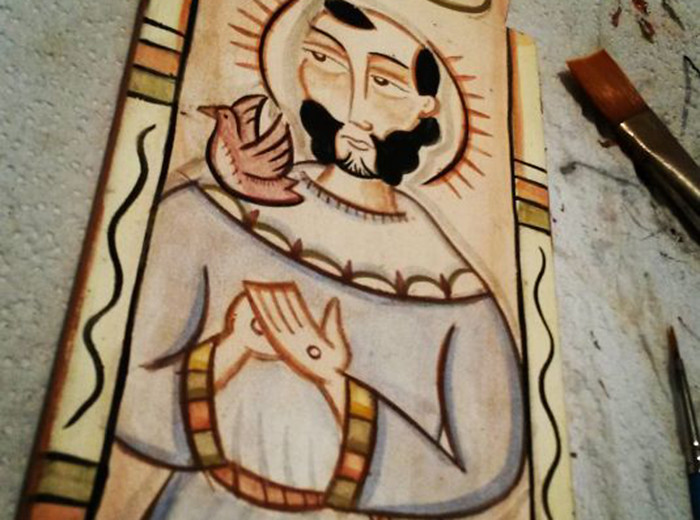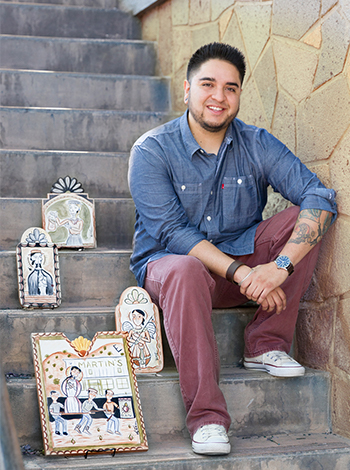Interpreting traditional retablos in a fun and whimsical way

Vincent Campos
For more than 17 years Lab employee Vincent Campos has created hand-painted retablos, an art form steeped in Spanish and Mexican tradition going back as far as the European Middle Ages. Known as lámina in Mexico, retablos depict a saint or some other iconography derived from the Roman Catholic Church painted on a tablet of wood or tin. The word “retablo” means “board behind,” as a retablo is traditionally found against the wall behind a church’s altar.
“I first discovered this style of folk art while in grade school,” Vincent remembers. “A world-renowned santero held a class for the youth in my town of El Rito. I went to the class and found I had a knack for drawing and expressing myself through the medium. The santero invited me to his studio, where he taught me the fundamentals of this traditional art. I then started practicing on my own, taking classes in woodcarving and the like. That’s how I got started—I’ve been doing it ever since.”
An art steeped in tradition
Although retablos have been around for centuries, the art form has a distinct flavor in the United States, where it has flourished in northern New Mexico and southern Colorado since the Spaniards explored and colonized the area.
“When the Spanish first settled in New Mexico, they set up missions,” Vincent explains. “The artwork for these missions was either brought from Spain or created in Mexico City. After the Pueblo Revolt of 1680, much of the artwork was gone. Rather than try to obtain new artwork from traditional sources, the people elected to make their own art using local materials.”

One of Campos's retablos.
Vincent notes that retablos are a very primitive style of art, principally because of the materials that were on hand to create them. Today, retablos continue this tradition, with the images lacking in detail around the faces.
“Those early artists were painting with chicken feathers and using antlers and rabbit skins to produce textures,” Vincent says. “With the railroads and the Santa Fe Trail, this tradition receded, and it wasn’t until the early nineteenth century that people rediscovered the art and started practicing it again.”
A modern flair for the traditional
Having created his share of traditional iconography, Vincent wanted to capture the attention of younger generations, including his own. While still keeping to traditional methods when it comes to producing materials for retablos, Vincent has injected fun and whimsy into his iconography, reinterpreting traditional stories so that they reflect contemporary values and concerns. He has taken advantage of the bright natural pigments found in northern New Mexico to give these paintings a much brighter and colorful flair. Vincent also gives his figures comical expressions, exaggerating facial features such as eyes or teeth.
“It’s a fine line,” Vincent admits. “I remain true to the original saints and their stories, but I do so in the contemporary world. I continue to create original retablos that reflect the traditional approach, and these I show at places like the Santa Fe Spanish Market. But when I go on my own artist tours, I showcase these nontraditional pieces, as they seem to get a lot of positive attention.”
The process of creation
Every artist has his or her own distinct approach to creation. For Vincent, his moment of creation is not planned or spontaneous but rather builds as he collects and creates all the materials needed to paint a retablo.
“Everything is either collected from nature or made by hand,” Vincent says. “I create glue from rabbit skins. I collect materials from throughout northern New Mexico to create my own pigments. There’s this bright green pigment, tierra verde, I cultivate from the Santa Ana Pueblo. Just coming up to Los Alamos, you will find some great colors, such as unusual and bright versions of yellows and reds. Then there’s the process of creating your own varnish for the wood, using grain alcohols mixed with sap from piñon trees. As all these preparations are being made, you have the time to come up with an idea based on the materials themselves. You know, things like this type of wooden board fits a certain saint. When it all comes together, that’s when the actual painting process begins.”

Vincent Campos.






